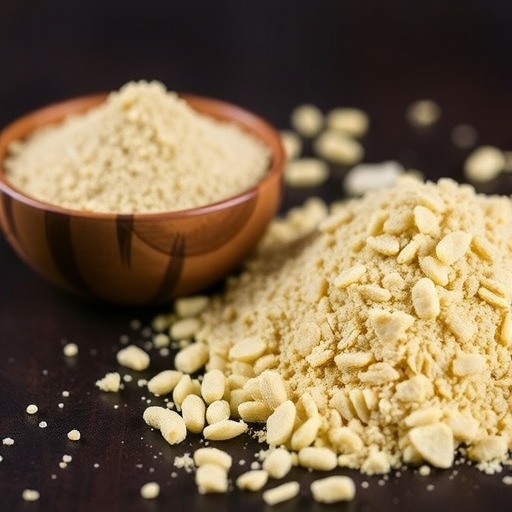In a breakthrough that could revolutionize the biotechnology and food industries, researchers have unveiled a novel approach to significantly boost glutathione production in yeast, without resorting to genetic modification techniques. This pioneering research centers on a specially selected mutant strain of Saccharomyces cerevisiae, isolated through an innovative screening method based on resistance to acrolein, a highly reactive aldehyde compound. The implications of this discovery are broad-ranging, potentially impacting everything from nutritional supplements to pharmaceutical manufacturing.
Glutathione is a tripeptide composed of glutamine, cysteine, and glycine, and it plays a crucial role in cellular antioxidant defense and detoxification mechanisms. Due to its potent antioxidant properties, glutathione has garnered substantial attention for its potential health benefits, including immune system support and anti-aging effects. However, commercial production of glutathione has faced challenges due to efficiency bottlenecks and regulatory hurdles linked to genetically modified organisms (GMOs). This report introduces a compelling solution that bypasses the GMO issue entirely.
The key innovation documented by the researchers lies in their method of selecting yeast mutants based on their ability to withstand acrolein, a toxic aldehyde known to cause cellular oxidative damage. By exposing Saccharomyces cerevisiae populations to acrolein and isolating survivors exhibiting enhanced resistance, the team effectively enriched for strains with superior oxidative stress response mechanisms. These mechanisms correlate strongly with elevated glutathione synthesis, as glutathione serves as a primary intracellular defense molecule against oxidative insults like acrolein.
One of the remarkable aspects of this research is the non-GMO nature of the mutant strain. Utilizing traditional mutagenesis and natural selection techniques, the researchers circumvented the need for inserting foreign genes or employing recombinant DNA technologies. This approach has significant commercial appeal, as it potentially alleviates consumer concerns regarding GMO products and can simplify regulatory approvals in various markets.
In detailed laboratory assays, the mutant strain demonstrated a marked increase in intracellular glutathione levels when compared to wild-type controls. This enhancement was quantifiable and reproducible, indicating stable mutational changes that conferred a robust biosynthetic advantage. The findings hold promise for scaling up production in industrial fermenters, enabling cost-effective manufacturing of glutathione-rich biomass for dietary supplements, cosmetics, and therapeutic formulations.
Beyond production capacity, the research underlines the metabolic and molecular underpinnings behind the increased glutathione yield. It appears that the acrolein-resistant mutants activate or sustain heightened activity of enzymes involved in the glutathione biosynthetic pathway, such as gamma-glutamylcysteine synthetase and glutathione synthetase. Furthermore, antioxidant systems including glutathione reductase seem upregulated, providing a comprehensive intracellular environment favorable for glutathione accumulation.
The methodology used to isolate the mutants also offers a template for future strain development targeting other valuable metabolites. By exploiting selective pressure via toxic compounds or environmental stressors, it may be feasible to tailor microbial chassis with enhanced performance traits without intruding into genetic engineering territories. This strategy aligns well with the growing demand for ‘natural’ and ‘clean label’ bioproducts.
Industrial implications of this innovative yeast strain are profound. The food industry, for instance, could integrate these glutathione-enriched yeasts into functional foods or beverages, elevating their antioxidant profiles and health benefits. In pharmaceuticals, glutathione’s role in drug detoxification and protective mechanisms suggests that efficient, scalable production could underpin novel treatments for oxidative stress-related diseases.
Moreover, the non-GMO status of the mutant could expedite market adoption, especially in regions with stringent anti-GMO regulations and consumer rejection of genetically modified products. Companies seeking to expand their antioxidant product lines may find this strain an attractive option to differentiate their goods through scientifically validated bioenhancement without regulatory setbacks.
From a scientific perspective, the study paves the way for deeper exploration into acrolein resistance mechanisms, which historically have been understudied. Understanding how cells mitigate damage from reactive aldehydes could unlock new approaches to engineering stress tolerance in various microorganisms, broadening the scope of industrial biotechnology applications.
The research also spotlights the critical role of oxidative stress management in microbial physiology. Glutathione, as a central redox regulator, modulates cellular homeostasis and viability under stress; thus, strains with optimized glutathione production capabilities may excel not only in metabolite synthesis but also in resilience to harsh fermentation conditions.
In addition to laboratory-scale evidence, further studies will be required to validate the performance of this mutant strain in large-scale industrial bioreactors. Parameters such as growth kinetics, substrate utilization efficiency, and stability under prolonged fermentation must be assessed to ensure commercial viability. However, the initial data provide a strong rationale for investment and development.
In summary, this groundbreaking work demonstrates a viable path to enhance glutathione production that aligns with both consumer acceptance and industrial practicality. By leveraging natural selection via acrolein resistance, the researchers have charted a course that reconciles the demand for high-yield antioxidants with regulatory and ethical considerations surrounding GMOs, potentially transforming glutathione biotechnology worldwide.
Future investigations could explore combinatorial screening with other stressors or metabolic modifiers to further amplify glutathione yields or improve co-production of synergistic antioxidants. Unlocking the full potential of this approach may catalyze a new era of microbial strain development, driven by phenotypic selection and metabolic insight rather than genetic engineering.
This advance resonates beyond the confines of yeast biotechnology, offering a paradigm for sustainable bioproduction of critical molecules through innovative yet natural methodologies. It may inspire a wave of research harnessing environmental pressures to sculpt superior microbial producers that meet rising global demands for health-enhancing biomolecules.
As glutathione’s therapeutic and nutraceutical relevance continues to ascend, integrating such engineered yet non-GMO yeast strains into commercial pipelines could accelerate availability and reduce costs, ultimately benefiting consumers seeking effective antioxidant solutions naturally sourced through biotechnological ingenuity.
Subject of Research:
Article Title:
Article References:
Nho, S.B., Do, SH., Oh, S. et al. Enhanced glutathione production by a non-GMO Saccharomyces cerevisiae mutant isolated via acrolein resistance-mediated screening. Food Sci Biotechnol (2025). https://doi.org/10.1007/s10068-025-01995-9
Image Credits: AI Generated
DOI: https://doi.org/10.1007/s10068-025-01995-9
Keywords:




